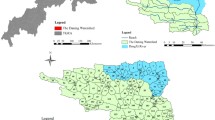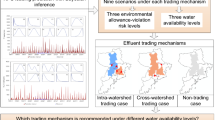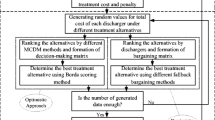Abstract
In this study, a robust simulation–optimization modeling system (RSOMS) is developed for supporting agricultural nonpoint source (NPS) effluent trading planning. The RSOMS can enhance effluent trading through incorporation of a distributed simulation model and an optimization model within its framework. The modeling system not only can handle uncertainties expressed as probability density functions and interval values but also deal with the variability of the second-stage costs that are above the expected level as well as capture the notion of risk under high-variability situations. A case study is conducted for mitigating agricultural NPS pollution with an effluent trading program in Xiangxi watershed. Compared with non-trading policy, trading scheme can successfully mitigate agricultural NPS pollution with an increased system benefit. Through trading scheme, [213.7, 288.8] × 103 kg of TN and [11.8, 30.2] × 103 kg of TP emissions from cropped area can be cut down during the planning horizon. The results can help identify desired effluent trading schemes for water quality management with the tradeoff between the system benefit and reliability being balanced and risk aversion being considered.










Similar content being viewed by others

References
Ahmed S, Sahinidis NV (1998) Robust process planning under uncertainty. Ind Eng Chem Res 37(5):1883–1892
Arnold JG, Srinivasan R, Muttiah RS, Williams JR (1998) Large area hydrologic modeling and assessment—Part 1: Model development. J Am Water Resour Assoc 34:73–89
Atamtürk A, Zhang M (2010) Two-stage robust network flow and design under demand uncertainty. Oper Res 55(4):662–673
Beraldi P, Musmanno R, Triki C (2000) Solving stochastic linear programs with restricted recourse using interior point methods. Comput Optim Appl 15(3):215–234
Bossa AY, Diekkrüger B, Giertz S, Steup G, Sintondji LO, Agbossou EK, Hiepe C (2012) Modeling the effects of crop patterns and management scenarios on N and P loadings to surface water and groundwater in a semi-humid catchment (West Africa). Agric Water Manag 115:20–37
Chen DJ, Lu J, Wang HL, Shen YN, Kimberley MO (2010) Seasonal variations of nitrogen and phosphorus retention in an agricultural drainage river in East China. Environ Sci Pollut Res 17(2):312–320
Chen C, Li YP, Huang GH, Zhu Y (2012) An inexact robust nonlinear optimization method for energy systems planning under uncertainty. Renew Energy 47:55–66
Cho JH, Sung KS, Ha SR (2004) A river water quality management model for optimising regional wastewater treatment using a genetic algorithm. J Environ Manag 73(3):229–242
Demirel MC, Venancio A, Kahya E (2009) Flow forecast by SWAT model and ANN in Pracana basin, Portugal. Adv Eng Softw 40(7):467–473
FitzHugh TW, Mackay DS (2000) Impacts of input parameter spatial aggregation on an agricultural nonpoint source pollution model. J Hydrol 236(1–2):35–53
Hamm V, Collon-Drouaillet P, Fabriol R (2008) Two modelling approaches to water-quality simulation in a flooded iron-ore mine (Saizerais, Lorraine, France): a semi-distributed chemical reactor model and a physically based distributed reactive transport pipe network model. J Contam Hydrol 96(1–4):97–112
Hao RX, Li SM, Li JB, Zhang QK, Liu F (2013) Water quality assessment for wastewater reclamation using principal component analysis. J Environ Inform 21(1):45–54
Holvoet K, van Griensven A, Seuntjens P, Vanrolleghem PA (2005) Sensitivity analysis for hydrology and pesticide supply towards the river in SWAT. Phys Chem Earth, Parts A/B/C 30(8–10):518–526
Hörmann G, Köplin N, Cai Q, Fohrer N (2009) Using a simple model as a tool to parameterise the SWAT model of the Xiangxi river in China. Quat Int 208(1–2):116–120
Kara SS, Onut S (2010) A two-stage stochastic and robust programming approach to strategic planning of a reverse supply network: the case of paper recycling. Expert Syst Appl 37(9):6129–6137
Kurek W, Ostfeld A (2013) Multi-objective optimization of water quality, pumps operation, and storage sizing of water distribution systems. J Environ Manag 115(30):189–197
Li YP, Huang GH (2009a) Two-stage planning for sustainable water-quality management under uncertainty. J Environ Manag 90(8):2402–2413
Li YP, Huang GH (2009b) Interval-parameter robust optimization for environmental management under uncertainty. Can J Civ Eng 36(4):592–606
Li FQ, Ye L, Liu RQ, Cao M, Cai QH (2008) Dynamics of main nutrient input to Xiangxi Bay of the Three-Gorge Reservoir. Acta Ecol Sin 28(5):2073–2079
Li FQ, Cai QH, Fu XC, Liu JK (2009) Construction of habitat suitability models (HSMs) for benthic macroinvertebrate and their applications to instream environmental flows: a case study in Xiangxi River of Three Gorges Reservior Region, China. Proc Natl Acad Sci U S A 19(3):359–367
Li YP, Li W, Huang GH (2012) Two-stage inexact-probabilistic programming model for water quality management. Environ Eng Sci 29(7):713–725
Luo B, Maqsood I, Huang GH, Yin YY, Han DJ (2005) An inexact fuzzy two-stage stochastic model for quantifying the efficiency of nonpoint source effluent trading under uncertainty. Sci Total Environ 347(1–3):21–34
Mei Y, Bi YH, Hu ZY (2012) Environmental factors on release of phosphorus from submerged soils in xiangxi bay. Environ Sci Technol 35(3):11–15 (In Chinese)
Mulvey JM, Vanderbei RJ, Zenios SA (1995) Robust optimization of large-scale systems. Oper Res 43(2):264–281
National Bureau of Statistics of China (2012) China statistical yearbook. China Statistical Press, Beijing (In Chinese)
Neitsch SL, Arnold JG, Kiniry JR, Williams JR (2009) Soil and water assessment tool theoretical documentation, version 2009. Grassland, Soil and Research Service, Temple
Ranga Prabodanie RA, Raffensperger JF, Milke MW (2009) Simulation–optimization approach for trading point and non-point source nutrient permits. 18th World IMACS/MODSIM Congress 233–239
Rico-Ramirez V, Frausto-Hernandez S, Diwekar UM, Hernandez-Castro S (2007) Water networks security: a two-stage mixed-integer stochastic program for sensor placement under uncertainty. Comput Chem Eng 31(5–6):565–573
Schönbrodt-Stitt S, Bosch A, Behrens T, Hartmann H, Shi XZ, Scholten T (2013) Approximation and spatial regionalization of rainfall erosivity based on sparse data in a mountainous catchment of the Yangtze River in Central China. Environ Sci Pollut Res 20(10):6917–6933
Shang X, Wang XZ, Zhang DL, Chen WD, Chen XC, Kong HN (2012) An improved SWAT-based computational framework for identifying critical source areas for agricultural pollution at the lake watershed scale. Ecol Model 226(10):1–10
Shen ZY, Gong YW, Li YH, Hong Q, Xu L, Liu RM (2009) A comparison of WEPP and SWAT for modeling soil erosion of the Zhangjiachong watershed in the Three Gorges Reservoir Area. Agric Water Manag 96(10):1435–1442
Song LX, Liu DF, Xiao SB (2011) Experimental study on nonpoint source nutrient output from Xiangxi watershed in Three Gorges Reservoir. Resour Environ Yangtze Watershed 20(8):990–996 (In Chinese)
Suh SW, Kim JH, Hwang IT, Lee HK (2004) Water quality simulation on an artificial estuarine lake Shiwhaho, Korea. J Mar Syst 45(3–4):143–158
Ti CP, Yan XY (2013) Spatial and temporal variations of river nitrogen exports from major basins in China. Environ Sci Pollut Res 20(9):6509–6520
Unami K, Kawachi T (2003) Universal optimization of water quality management strategy. Adv Water Resour 26(4):465–472
Wang HF, Huang YS (2013) A two-stage robust programming approach to demand-driven disassembly planning for a closed-loop supply chain system. Int J Prod Res 51(8):2414–2432
Wang F, Wang X, Zhao Y, Yang ZF (2012) Long-term water quality variations and chlorophyll a simulation with an emphasis on different hydrological periods in Lake Baiyangdian, northern China. J Environ Inform 20(2):90–102
Ward FA, Pulido-Velázquez M (2008) Efficiency, equity, and sustainability in a water quantity–quality optimization model in the Rio Grande watershed. Ecol Econ 66(1):23–37
Watanabe T, Ellis H (1993) Robustness in stochastic programming models. Appl Math Model 17(10):547–554
Xu HM, Taylor RG, Kingston DG, Jiang T, Thompson JR, Todd MC (2010) Hydrological modeling of River Xiangxi using SWAT2005: a comparison of model parameterizations using station and gridded meteorological observations. Quat Int 226(1–2):54–59
Yang DF, Zenios SA (1997) A scalable parallel interior point algorithm for stochastic linear programming and robust optimization. Comput Optim Appl 7(1):143–158
Yang LP, Mei K, Liu XM, Wu LS, Zhang MH, Xu JM, Wang F (2013) Spatial distribution and source apportionment of water pollution in different administrative zones of Wen-Rui-Tang (WRT) River watershed, China. Environ Sci Pollut Res 20(8):5341–5352
Zhang C (2008) Distributed non-point sources pollution modeling and its application in Xiangxi watershed. Tsinghua University, Dissertation (In Chinese)
Zhang W, Wang XJ (2002) Modeling for point–non-point source effluent trading: perspective of non-point sources regulation in China. Sci Total Environ 292(3):167–176
Zhang QC, Shamsi IH, Wang JW, Song QJ, Xue QY, Yu Y, Lin XY, Hussain S (2013) Surface runoff and nitrogen (N) loss in a bamboo (Phyllostachys pubescens) forest under different fertilization regimes. Environ Sci Pollut Res 20(7):4681–4688
Zhao XB, Fletcher JJ (2011) A spatial–temporal optimization approach to watershed management: acid minedrainage treatment in the Cheat River watershed, WV, USA. Ecol Model 222(9):1850–1591
Acknowledgments
This research was supported by the National Natural Sciences Foundation (51379075, 51225904, and 51190095), the National Basic Research Program of China (2013CB430401), the 111 Project (B14008), and the Program for Innovative Research Team in University (IRT1127). The authors are grateful to the editors and the anonymous reviewers for their insightful comments and suggestions.
Author information
Authors and Affiliations
Corresponding author
Additional information
Responsible editor: Michael Matthies
Rights and permissions
About this article
Cite this article
Zhang, J.L., Li, Y.P. & Huang, G.H. A robust simulation–optimization modeling system for effluent trading—a case study of nonpoint source pollution control. Environ Sci Pollut Res 21, 5036–5053 (2014). https://doi.org/10.1007/s11356-013-2437-8
Received:
Accepted:
Published:
Issue Date:
DOI: https://doi.org/10.1007/s11356-013-2437-8



